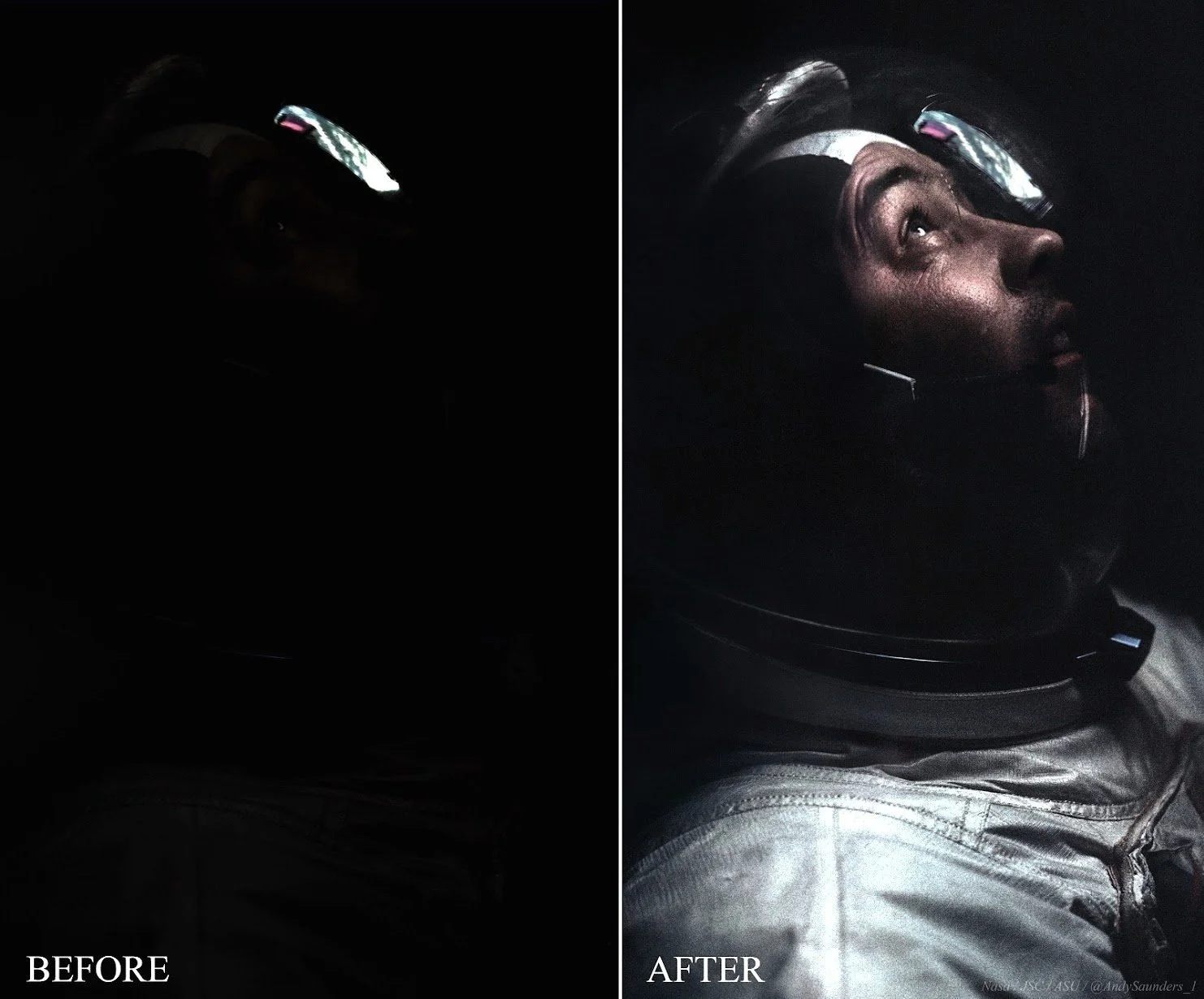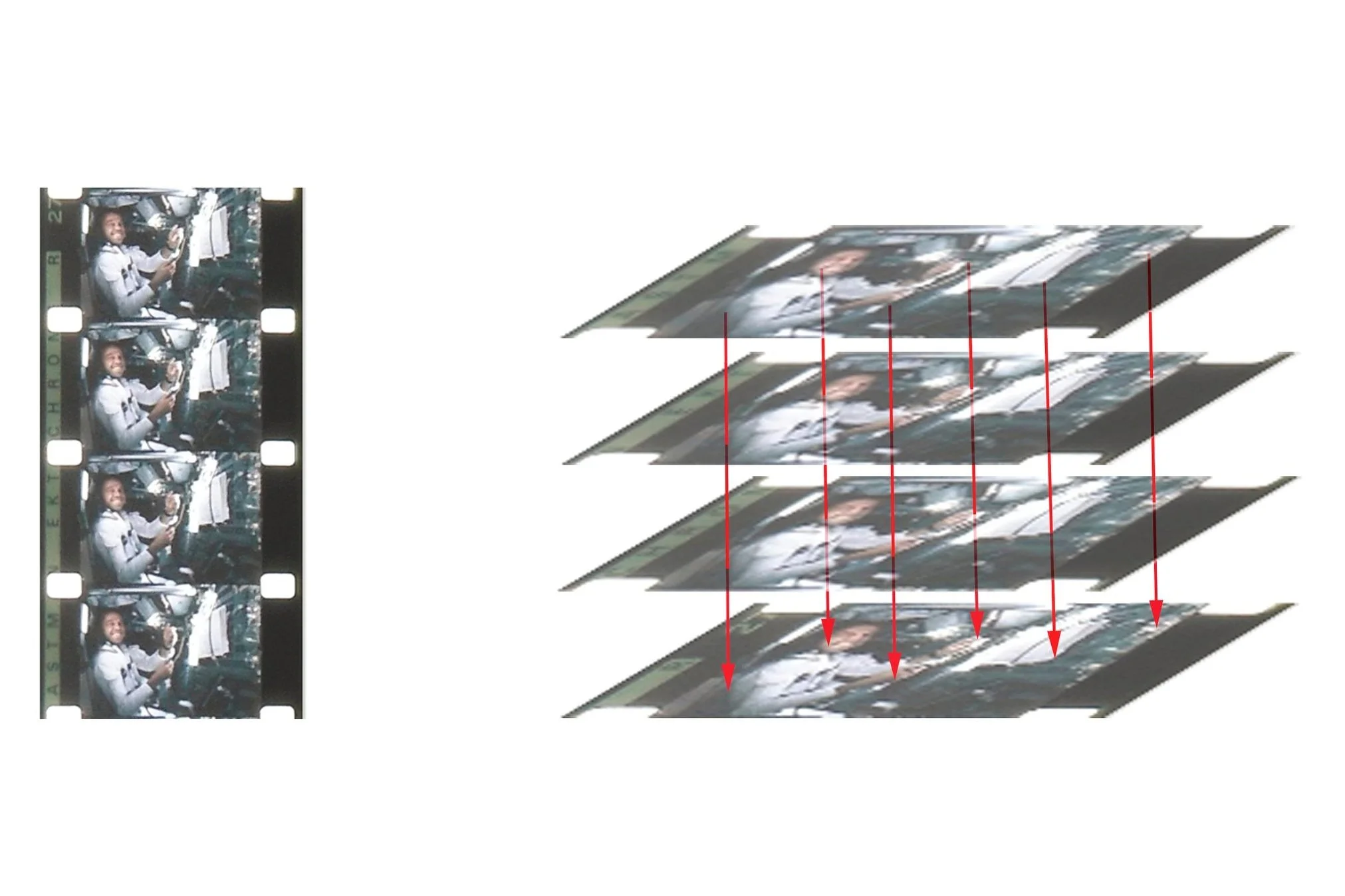About The Processing
The raw output from the digital scan of a 70mm Hasselblad frame, is a huge 1.3GB, 16-bit TIFF file. At approximately 11,000 pixels square, a single image would require a 12-foot x 12-foot computer monitor to display the whole image at standard resolution.
The files contain an incredible amount of information, but they require a significant amount of careful processing to tease out the detail and produce a well balanced image.
The transparencies were developed for an analog world, not for digital scanning – they originally required light to penetrate the “slides” to present the image correctly on light-sensitive paper or via projection. As a result, the raw scans typically show an apparently significantly underexposed image, often resembling an almost fully black frame, particularly if the original shot was also underexposed.
LEFT: Underexposed raw scan of original film. RIGHT: The remastered image. (NASA / JSC / ASU / Andy Saunders).
Once the signal is boosted sufficiently, a host of unwanted artifacts are introduced. Several techniques are applied to subdue these unwanted artifacts and create a balanced frame. Some of the key processing techniques subsequently applied, include local level and contrast adjustments, noise reduction, and digital removal of contaminants that were not removed during film cleaning, prior to the scan.
A critical element in presenting the images accurately is appropriate color correction. Many factors influence the color of the film - from ageing, to how is was originally processed (there are variances from magazine to magazine), to the angle of the Sun, the specific area of the Moon, the source of any reflected light, and even which type of window the photographs were shot through. Extensive research of transcripts of voice recordings from the missions, and post-mission reports, also provide insight as to how the astronauts observed color in the moment, and help inform decisions around color correction.
The overall extent of processing applied has been considered on an image-by-image basis and no AI has been used - the objective is to produce the most accurate representation of what the astronauts actually witnessed. To this end, some of the select few humans, the Apollo astronauts; who were there and actually took the photographs, have graciously contributed to this project. Walter Cunningham (Apollo 7), Rusty Schweickart (Apollo 9), Fred Haise (Apollo 13) and Charlie Duke (Apollo 16) have checked over and critiqued the images prior to print to ensure they are as accurate as possible and represent what they witnessed during their missions.
LEFT: A raw scan of overexposed film. RIGHT: The digitally restored image. (NASA / JSC / ASU / Andy Saunders)
16mm ‘Movie’ Film Stacking
In addition to the Hasselblad still cameras, the astronauts utilized a small-format ‘movie’ film camera - the 16mm DAC (Data Acquisition Camera), to record sequences of events for engineering assessment. However, the wider-angle lenses also captured brief moments inside the spacecraft.
In an effort to create a sense of intimacy not previously attainable, and to allow us all to ride along with these space explorers on what are the greatest ever human expeditions, a rigorous and transformative process has been undertaken to enhance this film.
Due to suffering from comparatively more image noise and a lack of detail inherent in smaller-format film, an image stacking principle, often employed in astrophotography, has been applied. Over recent years, Saunders evolved this process and developed a technique to effectively apply it to more dynamic scenes, especially for this unique historical footage.
The technique is based on the principle that every image contains a signal and noise. After stacking and aligning numerous frames, the signal is present on almost all frames, and in the same place. The noise however, is truly random. When calculating an individual value for each aligned pixel in the stack, we can average out the noise, while maintaining the signal. The more sample images, the better the averaging, with the improvement in the signal/noise ratio equal to the square root of the number of stacked images.
Image stacking principle applied to 16mm ‘movie’ film (Andy Saunders)
As many as several hundred separate frames are stacked, aligned and processed to produce a more photo-like output, revealing detail that has been lost for 50 years.
The improvement from stacking and processing 16mm film from Apollo 8, allows us to almost read previously entirely illegible documents. (NASA / Andy Saunders - Digital Source: Stephen Slater)


